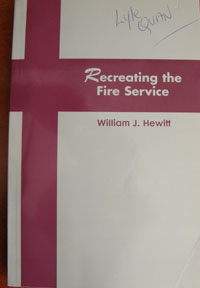
Features
Leadership
Cornerstone: Challenge for managers: change or recreate
One of the more famous, tongue-in-cheek sayings in the fire service is “100 years of tradition, unaffected by progress.” Does this mean that in the fire service we hold true to our traditions and respect them or does it mean we are slow to accept change, or both?
December 12, 2007
By Lyle Quan
 One of the more famous, tongue-in-cheek sayings in the fire service is “100 years of tradition, unaffected by progress.” Does this mean that in the fire service we hold true to our traditions and respect them or does it mean we are slow to accept change, or both?
One of the more famous, tongue-in-cheek sayings in the fire service is “100 years of tradition, unaffected by progress.” Does this mean that in the fire service we hold true to our traditions and respect them or does it mean we are slow to accept change, or both?
This question, along with two useful and respected books that we’ll explore here, relates to the concepts of recreating or changing and how to deal with them. The online dictionary www.thefreedictionary.com defines recreating as “to impart fresh life to; refresh mentally or physically,” whereas change is defined as “to cause to be different; to give a completely different form or appearance.”
 We all have encountered change in our lives. Our responses to change either make us stronger and more flexible or cause us to hold on tighter to that comfort zone of tradition. The first book I recommend on dealing with and managing change is Recreating the Fire Service (published by Kendall Publications, 1995). William Hewitt, who was the fire chief in Saskatoon when he wrote the book, starts off by noting that within the three years between 1992 and 1995, 29 CEOs from Fortune 500 groups such as IBM, Westinghouse and General Motors had been fired for failing to make changes quickly enough in their organizations. So what happened? Well, essentially, these managers stayed with their former success patterns too long.
We all have encountered change in our lives. Our responses to change either make us stronger and more flexible or cause us to hold on tighter to that comfort zone of tradition. The first book I recommend on dealing with and managing change is Recreating the Fire Service (published by Kendall Publications, 1995). William Hewitt, who was the fire chief in Saskatoon when he wrote the book, starts off by noting that within the three years between 1992 and 1995, 29 CEOs from Fortune 500 groups such as IBM, Westinghouse and General Motors had been fired for failing to make changes quickly enough in their organizations. So what happened? Well, essentially, these managers stayed with their former success patterns too long.
Fire management is certainly more accountable now than in decades past to the needs of the community. Indeed, chiefs and officers are now responsible for creating strategic plans that are both fiscally responsible and flexible in their design. These strategic plans should prove that the fire management is looking to the future and is flexible in its strategies. Too often, many of our chief officers resist change and then fail to see the writing on the wall. These kinds of situations end in one of three ways: chiefs retire before they are totally overwhelmed by the challenges; the chief is fired by council because council is not seeing the leadership it needs to bring the fire service into the next decade; or, ideally, the fire chief understands the need to adjust and adapt and works to create a realistic future for the department.
Hewitt’s book is a must read for those in senior positions who are looking for plain-language suggestions on how to deal with changing or recreating the fire service. Because of Hewitt’s understanding of the fire service and of the expectations of municipal councils, he takes readers through areas that can and should be changed, such as a more progressive leader-management style instead of the traditional boss-worker style. At the same time, he touches on those sacred cows that managers should stay away from if they want buy-in from their staff, such as established work shifts, compressed work weeks and the ability to change work days with others. Readers may not totally agree with these sacred cows but managers should at least consider these when deciding what needs to be changed or recreated – in other words, what needs to be different as opposed to what can be recreated or refreshed.
Hewitt’s book addresses topics such as: preparing for opportunity; what makes one fire department more successful than another; re-engineering and trust within the fire service; and strategic planning.
 In the second book, Who Moved My Cheese (published by G.P. Putnam’s Sons, 1998), author Spencer Johnson takes us though a story about four characters in a maze who cannot find their cheese where it usually is located. The cheese is a metaphor for what you want in life, such as relationships, money or a good job, while the maze represents the organization in which you work or the community in which you live. This best-selling book describes how different people deal with change and emphasizes the need to anticipate change, enjoy it and, most importantly, be ready to quickly change again and again. As fire service managers, we owe it to our staffs and the communities to not to stand still and hope that things will eventually return to normal.
In the second book, Who Moved My Cheese (published by G.P. Putnam’s Sons, 1998), author Spencer Johnson takes us though a story about four characters in a maze who cannot find their cheese where it usually is located. The cheese is a metaphor for what you want in life, such as relationships, money or a good job, while the maze represents the organization in which you work or the community in which you live. This best-selling book describes how different people deal with change and emphasizes the need to anticipate change, enjoy it and, most importantly, be ready to quickly change again and again. As fire service managers, we owe it to our staffs and the communities to not to stand still and hope that things will eventually return to normal.
Remember the excerpt from Hewitt’s book about the CEOs who had been fired? Clearly, they decided to wait and hope that the cheese would return instead of anticipating, and embracing the need for change. I’m sure when you read Who Moved My Cheese you will identify with the four characters and how each one deals with the situation.
The question, then, is, whether, as a manager, you are going to change your organization or recreate it? Do you throw the baby out with the bath water because your fire department needs to start from scratch or do you refill the bath with some fresh water because that is what is required to take care of the baby (organization) and the situation? There’s nothing wrong with holding on to tradition. Problems occur when that grip becomes so tight that you are not able to relax and accept new ideas.
Who Moved My Cheese can be purchased through Chapters or Amazon, or you can check out www.whomovedmycheese.com. Due to the age of Recreating the Fire Service, it’s a bit difficult to locate. You’ll need to go to Amazon.ca or Kendall Publishing.
Lyle Quan is the deputy fire chief – administration with the Guelph Fire Department in Ontario. A 26-year veteran of emergency services, he is a graduate of Lakeland College’s Bachelor of Applied Business: Emergency Services and Dalhousie University’s Fire Service Leadership and Administration Programs. E-mail: thequans@sympatico.ca
Print this page